St Augustines Road Flood Alleviation (2023)
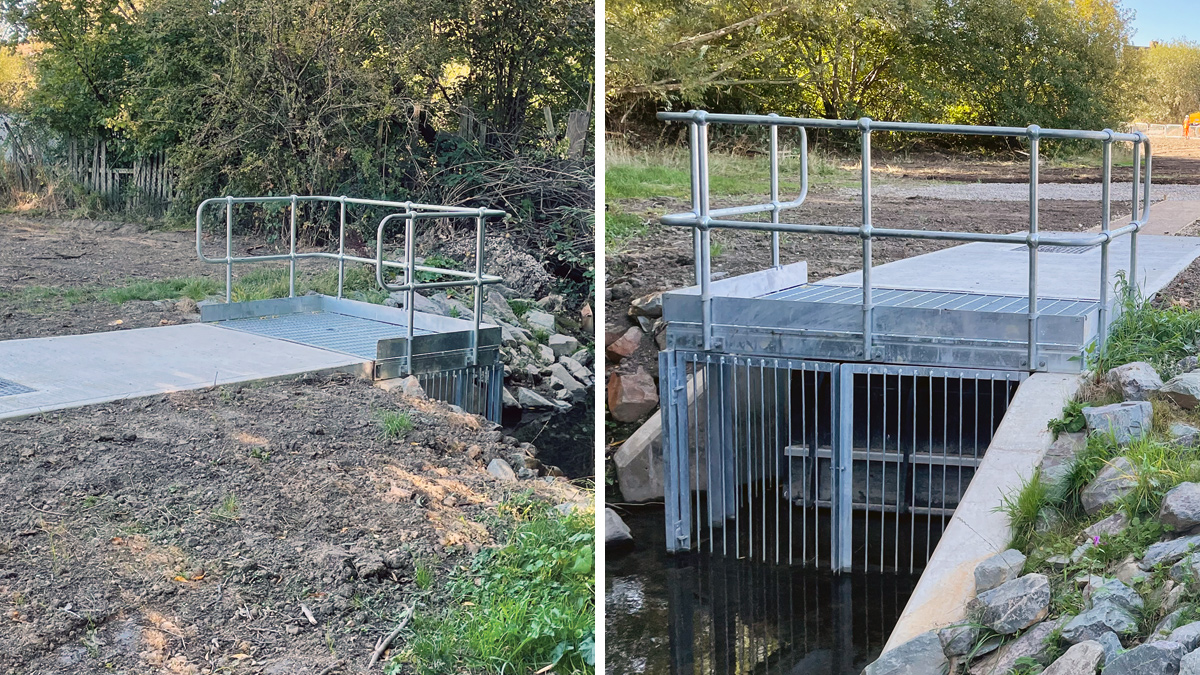
(left Completed headwall and (right) grille and handrailing to outfall - Courtesy of Galliford Try
St Augustines Road is a busy thoroughfare in Chesterfield linking the town to Matlock and the south-eastern edge of the Peak District. Lying within the Yorkshire Water (YW) waste catchment area, the road is steep in its nature with gradients often exceeding 7%. Due to the local hydraulic catchment and topography, during heavy rainfall events flooding occurred at the road’s intersection with Derby Road (A6). The flooding lifted manhole covers from their frames which caused significant damage to the highway. It also caused internal and external damage to the surrounding properties. To combat this, mitigation was carried out by Yorkshire Water and Chesterfield Borough Council (CBC), including the implementation of mitigation measures such as non-return air bricks and flood gates, however, this had limited success. CBC also commissioned the construction of a detention basin to the rear of the flooding properties; but again with limited success.
Hydraulic study
As a result of the mitigation’s limited success, a hydraulic study was commissioned by Yorkshire Water. This confirmed the root cause of the flooding was hydraulic overloading of both the foul and surface water sewers. A notional solution was developed by Yorkshire Water which included the upsizing of these sewers, with some form of temporary storage for the foul system to retain flows in a rainfall event. Later iterations of the hydraulic model revealed that improvements to the surface water network would in fact also reduce the frequency of flooding on the foul water network due to interactions between the two systems during storm conditions. In light of this information, in May 2021 Yorkshire Water secured funding to implement a series of significant improvements on St Augustines Road.
Preferred solution
The preferred solution included the construction of a new outfall into the River Rother and the transfer of all flows from the surface water sewer in Derby Road. This would provide a much greater flooding resilience in the existing system. The existing 225mm surface water sewer was to be upsized to Ø750mm along its 320m length. It would then be diverted via a tunnel underneath Derby Road into the wetland area immediately adjacent into the River Rother. Here, a new outfall would be constructed to discharge the surface water sewer into the river network.
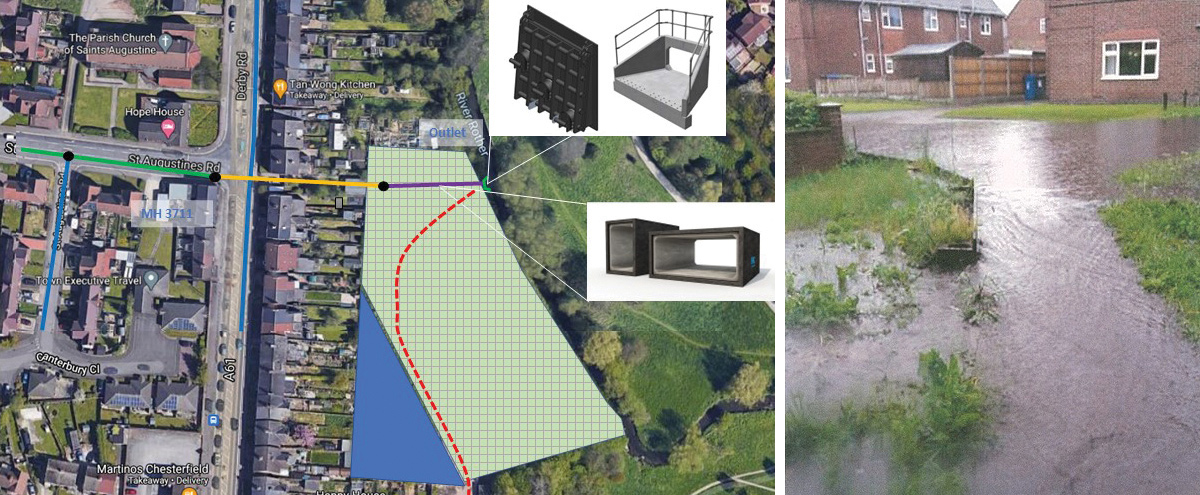
(left) The preferred option and (right) flooding on St Augustines Road – Courtesy of Galliford Try
Constraints and engineering challenges
The preferred solution progressed to detailed design with several technical challenges to be overcome. Several of these challenges were exacerbated by the need to construct the outfall into the River Rother outside of the salmonoid spawning season. An Environment Agency (EA) bespoke Flood Risk Assessment Permit, (FRAP) was required to construct the outfall and all in-channel activities were required to be undertaken before 1 October 2021 in order to mitigate the impact on any spawning salmon.
A significant flow rate of up to 0.89m3/s would be discharged into the river during storm events and river scour was a concern. In order to combat the scour on the riverbed and riverbanks, there was a requirement to reduce the velocity of the flow before it interacted with the River Rother, causing excessive turbulence. To achieve this, box culverts were selected due their unique cross section and significant channel width. This slowed velocities down to near 1m/s, which is widely regarded to have negligible effects on turbulence and thus reducing scour. The headwall was also designed to allow flows to enter the River Rother at a 45° angle, as per EA Standard Rules SR2015 guidelines, further reducing the risk of scour on the opposite riverbank and riverbed.
Outfall design
This design however did not come without complications, such as the need to carry out the structural design, build and installation of a bespoke outfall within a few months. BSP Consulting was commissioned to carry out the structural design of the outfall which was to be precast, reducing the need for in situ concrete handling adjacent to the sensitive receptor. Off-site build (OSB) also reduced the construction programme and allowed the headwall to be manufactured concurrently within the determination period of the FRAP.
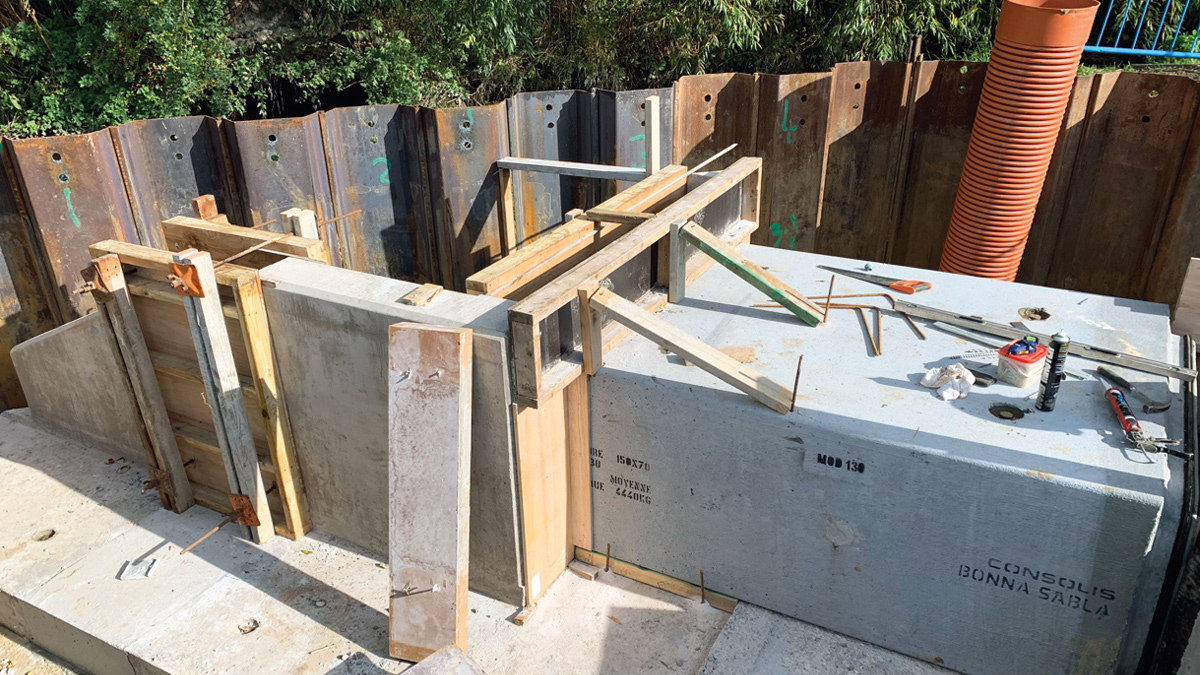
Outfall under construction – Courtesy of Galliford Try
Poor ground and underfoot conditions adjacent to the River Rother proved too risky and problematic for traditional mobile crane lifts, so all lifts of the precast sections were to be undertaken with a tracked excavator. This further constrained the design and restricted the maximum mass of each section to 13 tonnes. Consequently, in its final iteration the precast headwall was designed in two sections and was combined with an in situ toe and infill slab/wall which completed the structural design.
Design
During the design stages, extensive ground investigation was carried out. This identified water bearing sand and gravel strata adjacent to the river which transitioned to mudstones and clays towards St Augustines Road. It was this change in strata which posed a significant challenge for the no-dig section of the work beneath Derby Road. This section of work was critical as it linked the outfall to the upsizing work on St Augustines Road.
Discussions were held with Active Tunnelling Ltd who proposed the use of the guided auger bore technique to install the sewer in this transitional strata. Although initially designed as a 750mm diameter sewer, this was reduced to 600mm which was the maximum diameter which could be accommodated by the tunnelling contractors.
Hydraulic modelling was undertaken by RES Environmental to confirm the viability of this proposal and in order to compensate for this localised throttling, the pipeline had to be upsized locally to 900mm immediately upstream of the tunnel.
The alignment of the tunnel was severely limited due to proximity of existing buildings on Derby Road. BSP Consulting was again called into action as pre-condition surveys and settlement calculations were commissioned in order to understand the impact of the tunnelling works on these at-risk properties.
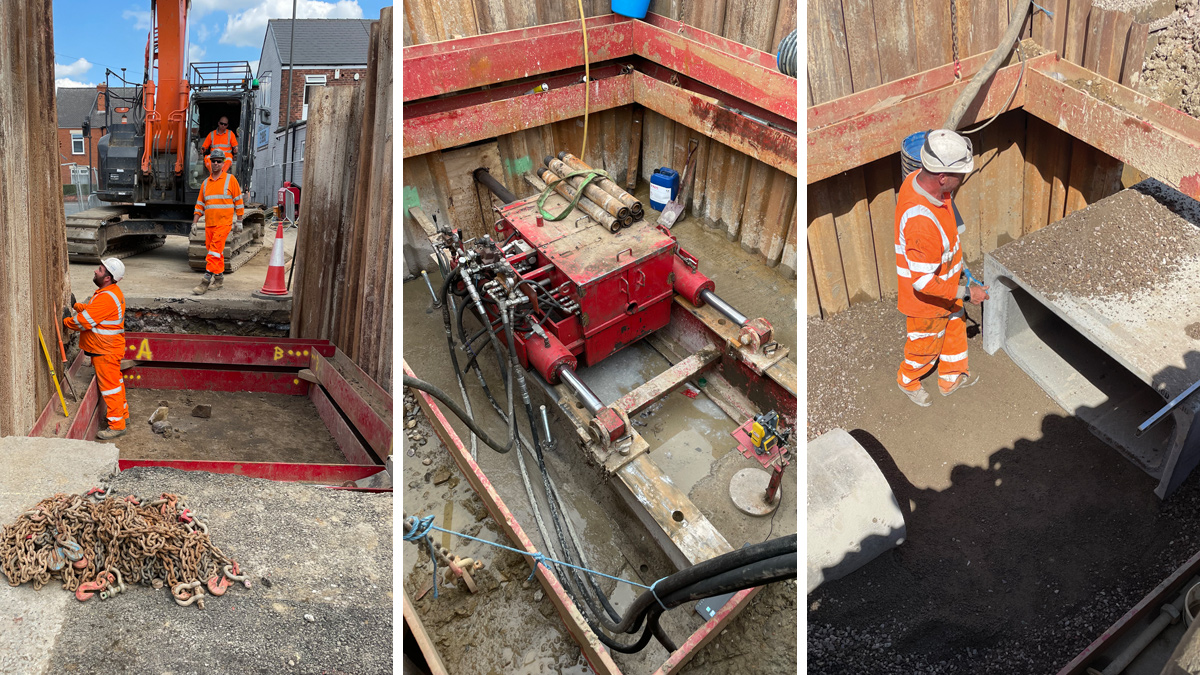
(left) Installation of drive pit on St Augustines Road, (middle) guided auger bore rig, and (right) the transition between 600mm and culverts – Courtesy of Galliford Try
Settlement calculations were undertaken using the “Guide to best practice for the installation of pipe jacks and microtunnels technique” and a predicted settlement of <3mm was deemed to be acceptable. The pre-condition surveys highlighted only minor cosmetic issues and were used as reference to the state of repair of the properties prior to construction work commencing.
The majority of the civil design was undertaken in house. This element included a design coordination role combining and processing the information received from the consultants and stakeholders. An example of the numerous stakeholders which were consulted is that of the Coal Authority. Initial searches indicated the presence of historical coal workings. More detail was sought and records indicated the presence of an adit within 20m of the proposed pipeline. A coal permit was sought from the Coal Authority and the design progressed whilst this was processed.
St Augustines Road (Chesterfield) Flood Alleviation: Supply chain: key participants
- Principal contractor & civils design: Galliford Try
- Temporary works & headwall design: BSP Consulting
- Hydraulic modelling: RES Environmental Ltd
- Ecological consultants: Middlemarch Environmental
- Traffic management: Amberon Traffic Management
- GRP & utility mapping: Cloud Conversion
- Ground investigation: Grange Geo Consulting Ltd
- Pipelaying & outfall construction: Arthur Civil Engineering
- Trenchless installation: Active Tunnelling Ltd
- Cofferdam design & supply: National Trench Safety UK
- ‘EndSafe’ safety barrier: Groundforce Shorco
- Cofferdam installation: Ivor King The Piling People
- Dewatering: Alba De-Watering Services Ltd
- Precast concrete: Bonna Sabla
- CCTV, CIPP & cleansing: CPS Drainage Solutions
- Handrailing & grille design: Galliford Try (Fabrications)
- Silt curtain: Murlac Land and Marine Environmental Solutions
- Pumping: Selwood Ltd
- Ridgistorm pipes: Polypipe Civils
- Pipe & flap valve supplier: Keyline Civils Specialists
- Landscaping & site clearance: Landscape Maintenance Services Ltd
- Reinstatement of traffic signals & street furniture: Swarco
- Aggregates & muck away: JC Balls & Sons
- Brickwork: Derwent Joinery & Construction
- Gates & fencing: SFC (Midlands) Limited
- Surfacing: BDS (Yorkshire) Ltd
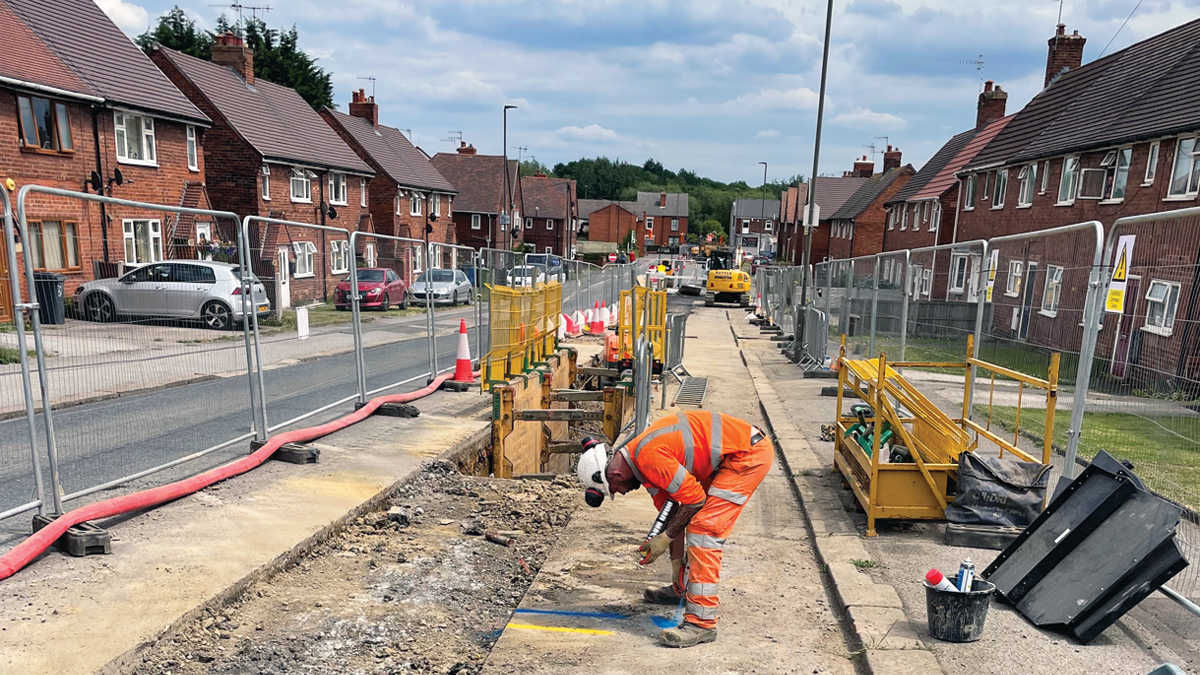
Service detection – Courtesy of Galliford Try
Installation
The Environment Agency granted the FRAP on 13 August 2021, and the detailed design was finalised and submitted to Yorkshire Water’s technical approval committee on 16 August 2021. Work began on site a few days later, leaving just six weeks to construct the headwall and cease all in-channel activities as per the conditions of the FRAP. Work commenced immediately on the enabling works, with particular attention paid to the temporary works.
Haul road
To provide drainage to the waterlogged land adjacent to the River Rother, a land drainage scheme was commissioned, designed and installed by Lincolnshire Drainage. This provided a more suitable foundation on which to install the haul road and working laydown areas. The haul road was designed by BSP Consulting and was of substantial construction given the underlying strata, at 700mm thickness with geotextile layers to improve longevity.
Ground dewatering
After the installation of the haul road, wellpoint dewatering was installed around the outfall area and along the proposed culvert alignment. The dewatering was installed by Alba De-Watering Services Ltd at 1.5m centres. However, due to the underlying mudstone, each well had to be pre-augered and was then installed using the more traditional spout method to ensure that a reasonable well depth was achieved to adequately dewater the working area. A silt curtain was supplied and installed by Murlac Land and Marine Environmental Solutions prior to the channel works to minimise silt and sediment damage downstream from the works. It proved to be very effective during the cofferdam installation.
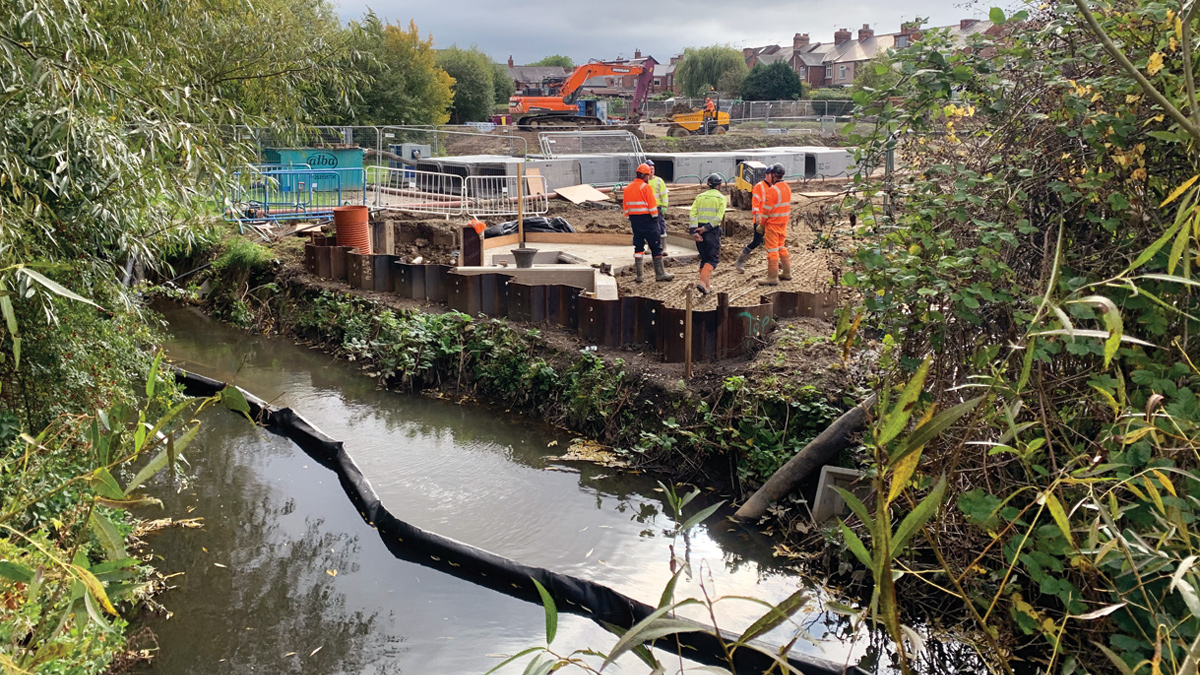
Cofferdam and silt curtain – Courtesy of Galliford Try
Cofferdam
A cofferdam was required to retain the River Rother and this was designed and supplied by National Trench Safety UK and installed by the primary subcontractor Arthur Civil Engineering. The cofferdam was unique in design in that it utilised Larsson piles in a trapezium shape (plan) to minimise over-dig yet still accommodate the headwall and first culvert.
The cofferdam was installed by Ivor King The Piling People using a 35t excavator with a Movax side grip pile driver attachment. The cofferdam was effective but 4” end suction pumps supplied by Selwood Ltd were still required to maintain the cofferdam and keep water levels low.
Headwall installation
Once the cofferdam was watertight, the headwall toe was cast in situ, after which the precast headwall arrived in two sections as planned. It was lifted into position by Arthur Civil Engineering using a 50t tracked excavator. An administrative issue led to the need to negotiate a 2-week FRAP extension with the EA and the headwall was completed and the cofferdam removed by 14 October in accordance with the conditions of the revised FRAP.
Pipeline works
Construction works on the remainder of the project continued in March 2022. A temporary one-way system was implemented to provide a safe working area to install the remainder of the pipeline with open cut works commencing on 14 March. The open cut works progressed steadily with over 100 services safely crossed. The later spring and summer months provided excellent conditions for online sewer relay with drought-like conditions, culminating in hosepipe bans for the majority of the UK.
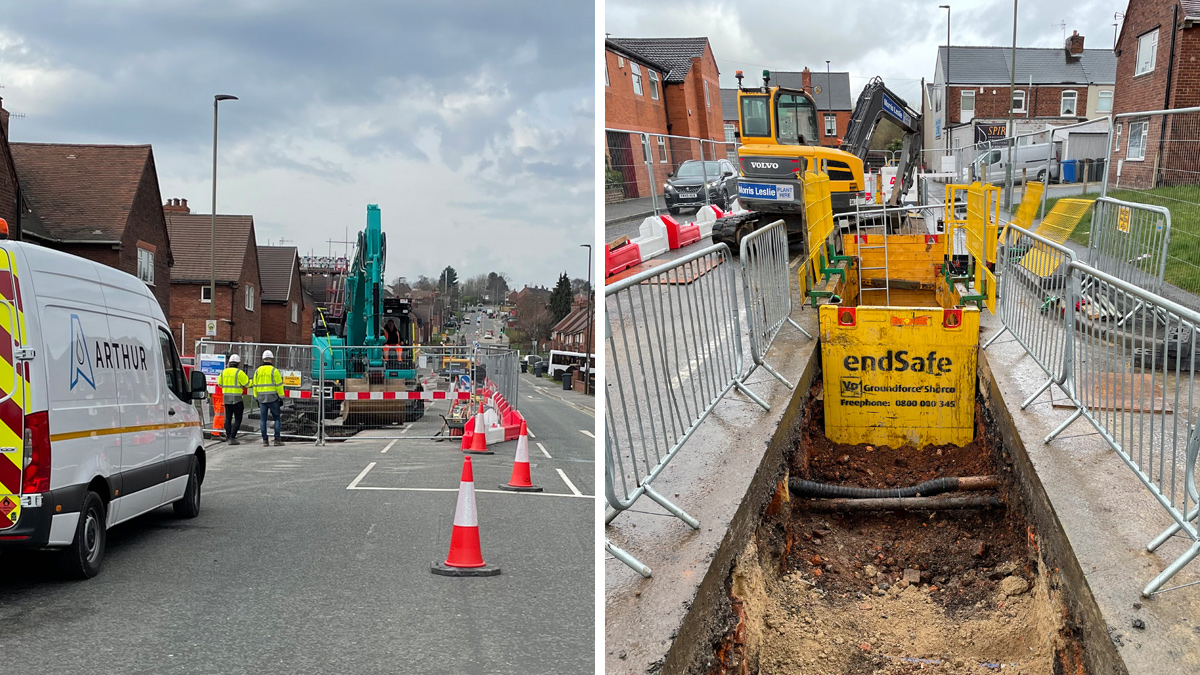
Open cut pipelaying – Courtesy of Galliford Try
Prior to the tunnelling works commencing, concern was raised over the proximity of the tunnel as it crossed under a 225mm foul water sewer in Derby Road. With a clearance of just 300mm, the existing foul sewer was inspected by CPS Drainage Solutions using CCTV and a precautionary 5m cured-in-place patch liner was installed to strengthen the sewer prior to the guided auger bore operation. No-dig works commenced in early June and progressed well without incident and were completed towards the end of the summer. No settlement was detected during the installation and no visual deformations were reported from the nearby structures.
Open cut works continued late into the summer with flooding benefits delivered by 5 October. Significant rainfall events have since occurred and the feedback from residents previously affected by the flooding has been positive.
Off-site build
Off-site build was utilised heavily without which it would not have possible to abide by the conditions set in the FRAP and achieve the tight programme when constructing the outfall into the River Rother. The headwall and culvert manhole cover slabs were precast by Galliford Try off site and the hand railing and grille were fabricated by Galliford Try (Fabrications). The flap-valve was fabricated off-site by Keyline Civils Specialists.
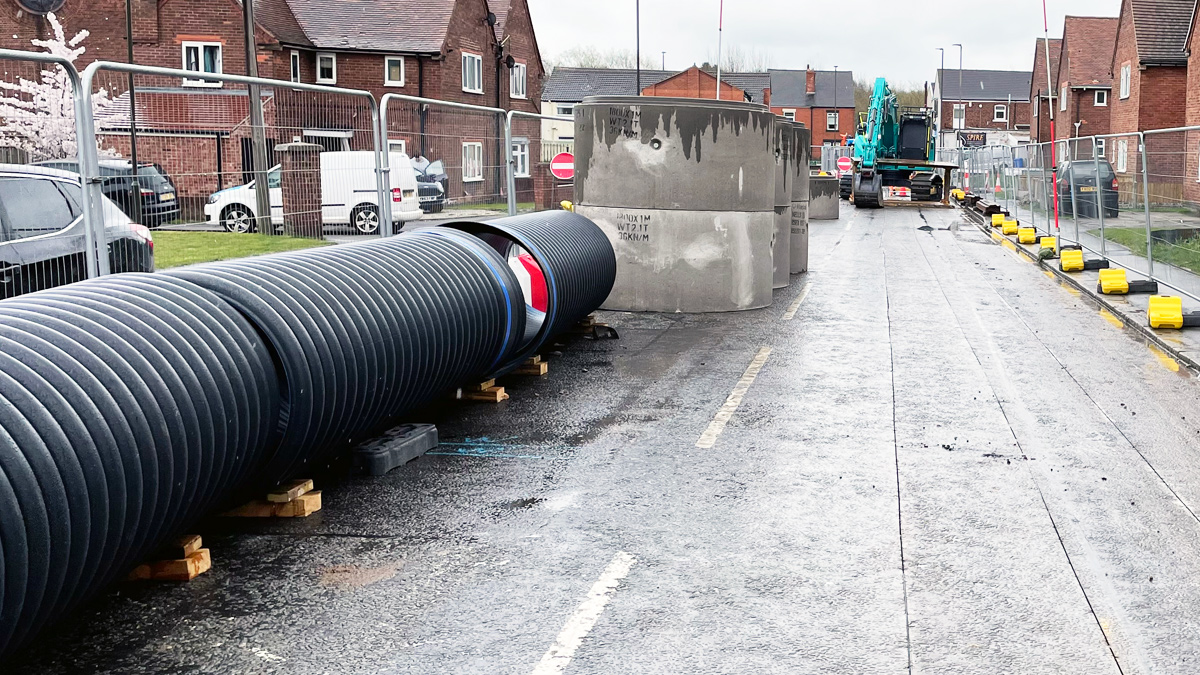
900mm Ridgistorm pipe from Polypipe Civils ready for installation – Courtesy of Galliford Try
Public engagement & community impact
Throughout the project customer engagement was a priority for Galliford Try and Yorkshire Water. Although COVID-19 curtailed some of the engagement meetings which were planned at the start of the project, regular communication with residents of St Augustines Road and surrounding area took place. A significant quantity of the communication was made to the local residents Facebook group, which provided timely and accurate updates on progress. Traditional letters were also posted as back up and for those who didn’t have access to Yorkshire Water’s online updates.
Towards the end of the project volunteers from Galliford Try and Yorkshire Water spent a day helping out at the local food bank on St Augustines Road and made a donation of £500 to assist with their ongoing charitable cause.
Project success
The project is considered huge a success for Galliford Try and is the largest single project completed on the Infrastructure Framework for Yorkshire Water within the AMP7 period.





